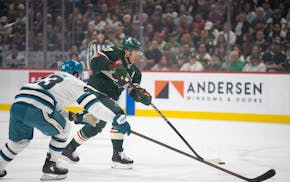Minnesota deer hunters will provide crucial data to wildlife biologists this weekend in what will be the largest sampling effort yet in the state's fight against the spread of chronic wasting disease (CWD).
"We need help from hunters,'' said Erik Hildebrand, wildlife health specialist for the Department of Natural Resources. "It's the only way to get a handle on the problem.''
In 30 out of 130 deer permit areas around the state, CWD testing will be mandatory Saturday and Sunday for all deer age one or older. The requirement should produce about 22,000 samples from six zones — far more testing than last year and enough to further measure the prevalence and whereabouts of a contagious animal disease that darkens the future of deer hunting.
New this year is a regional CWD surveillance zone centered around a defunct deer farm northeast of Bemidji. The case set off alarms this year when state officials detected the disease inside the farmer's fence and later discovered that the farm illegally dumped infected deer remains on nearby public land. The blatant biohazard for wild deer is now enclosed by a $200,000 fence paid for by taxpayers
Because there's no sanctioned way to test live deer for CWD, this weekend's sampling of hunter-harvested whitetails will examine for the first time whether the neurological disease likened to Mad Cow Disease has spilled into Beltrami County's woods and surrounding tribal land.
DNR Northwest Region Wildlife Manager Blane Klemek said this weekend's hunt should bring in approximately 1,800 deer from four permit areas stretching from near Lake Itasca in the southwest to Big Fork in the northeast. The zone includes land east of Upper Red Lake and within the Leech Lake Reservation boundary.
Half of Minnesota's annual deer harvest occurs over the opening weekend of the firearms season. Mandating tests on those two days is the surest way to determine whether wild deer in the corresponding areas have become infected, Klemek said.
"Statistics tell us that a sample size of this amount gives us a high probability of detecting the disease,'' he said.
Staffing 56 % of the sampling stations also will allow the DNR to educate hunters about CWD's threat to deer health, human health and explain the state's plan to slow it down. The U.S. Centers for Disease Control and Prevention advises people not to eat meat from deer or elk that look sick or test positive for CWD. In areas where CWD has been detected, the federal agency also advises hunters to wear gloves when field-dressing carcasses, bone out the meat, and minimize handling of brain and spinal cord tissues. That's where infectious prions are most likely to reside.
According to the DNR, 118 free-ranging deer have tested positive for CWD since the state first detected the scourge in a dead wild deer near Rochester in 2010. Southeastern Minnesota is the biggest hot spot, but even in that region, the prevalence of the disease is considered relatively low.
Wildlife managers responded to positive cases by offering extra hunts and paying federal sharpshooters to aggressively thin herds in the affected areas, slowing transmission.
This year's mandatory collection of lymph nodes from wild deer will resume Nov. 20 and 21 during the first two days of southeastern Minnesota's "B" season. Altogether, DNR will deploy 300 staff members and 175 university students or volunteers to collect the tissues in 56 different locations. Another 44 sampling locations will operate on a self-service basis.
What follows is a guide for hunters who bag a deer this weekend in any of Minnesota's six CWD zones:
- Consult DNR's interactive deer hunting map and click on your Deer Permit Area. The pop-up will say if testing is mandatory.
- While in the field, attach a blue site tag that came with your license to the ear or antler of your deer.
- Register your deer by phone, over the internet or at a walk-in big game registration station. Getting your deer sampled for CWD is not a method of registration.
- To find a CWD sampling station near you, consult DNR's CWD sampling map. At staffed locations, officials will remove the deer's lymph nodes for you. At self-service locations, submit lymph nodes or drop off deer heads in collection boxes. Follow instructions to provide data about the deer, including harvest location as described on the map provided at the site.
- Staffed sampling stations will operate from 9 a.m.-7 p.m. Saturday and Sunday. Self-service sampling stations are available through Monday.
- Abide by carcass movement restrictions. Largely this means keeping the carcass of your deer in the CWD zone until test results show CWD was "undetected.'' You can remove venison from the zone if you quarter your deer and take only the meat. The main leg bone can remain in each quarter. Or take the deer to a meat processor within the zone.
- To aid hunters in CWD testing areas, DNR is providing carcass dumpsters at designated locations. DNR worked with pollution control officials to determine safe sites for disposal in lined landfills or by incineration.
- DNR says you can expect individual test results in seven to 14 days. Results will be available electronically at mndnr.gov/cwdcheck or by calling the DNR Information Center at 888-646-6367. A DNR official will contact you only if your deer tests positive for CWD.
Third-quarter blitz helps Wolves beat Grizzlies in pivotal game
![Lakeville North head coach John Oxton was not pleased with a call in the second half. ] CARLOS GONZALEZ ï cgonzalez@startribune.com ñ March 21, 2018](https://arc.stimg.co/startribunemedia/SA2Y32ZP37ZZCXKPUIS5W4MUYA.jpg?h=91&w=145&fit=crop&bg=999&crop=faces)
Lakeville North boys basketball coach announces retirement

Souhan: Kirill Kaprizov's return gives hope to the Wild future

Royals slide past Twins, take three of four in early season series

